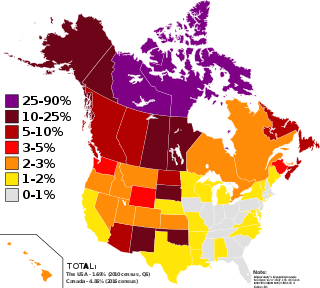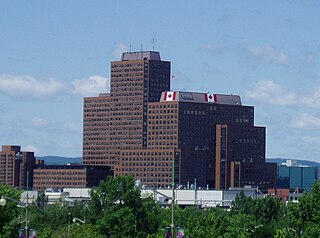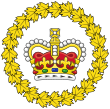
The Innu / Ilnu or Innut / Innuat / Ilnuatsh ("people"), formerly called Montagnais from the French colonial period, are the Indigenous inhabitants of territory in the northeastern portion of the present-day province of Labrador and some portions of Quebec. They refer to their traditional homeland as Nitassinan or Innu-assi.

In Canada, indigenous groups comprise the First Nations, Inuit and Métis. Although Indian is a term still commonly used in legal documents, the descriptors Indian and Eskimo have fallen into disuse in Canada, and most consider them to be pejorative. Aboriginal peoples as a collective noun is a specific term of art used in some legal documents, including the Constitution Act, 1982, though in most Indigenous circles Aboriginal has also fallen into disfavour.
First Nations is a term used to identify those Indigenous Canadian peoples who are neither Inuit nor Métis. Traditionally, First Nations in Canada were peoples who lived south of the tree line, and mainly south of the Arctic Circle. There are 634 recognized First Nations governments or bands across Canada. Roughly half are located in the provinces of Ontario and British Columbia.

The minister of Crown–Indigenous relations is a minister of the Crown in the Canadian Cabinet, one of two ministers who administer Crown-Indigenous Relations and Northern Affairs Canada (CIRNAC), the department of the Government of Canada which is responsible for administering the Indian Act and other legislation dealing with "Indians and lands reserved for the Indians" under subsection 91(24) of the Constitution Act, 1867. The minister is also more broadly responsible for overall relations between the federal government and First Nations, Métis, and Inuit.
In Canada, an Indian reserve is specified by the Indian Act as a "tract of land, the legal title to which is vested in Her Majesty, that has been set apart by Her Majesty for the use and benefit of a band." Indian reserves are the areas set aside for First Nations, an indigenous Canadian group, after a contract with the Canadian state, and are not to be confused with land claims areas, which involve all of that First Nations' traditional lands: a much larger territory than any reserve.
The Indian Register is the official record of people registered under the Indian Act in Canada, called status Indians or registered Indians. People registered under the Indian Act have rights and benefits that are not granted to other First Nations people, Inuit, or Métis, the chief benefits of which include the granting of reserves and of rights associated with them, an extended hunting season, easier access to firearms, an exemption from federal and provincial taxes on reserve, and more freedom in the management of gaming and tobacco franchises via less government interference and taxes.
The Federal Interlocutor for Métis and Non-Status Indians was a title and role in the Canadian Cabinet that provided a liaison for the federal Canadian government, and its various departments, to Métis and non-status Aboriginal peoples, and other off-reserve Aboriginal groups.

Crown–Indigenous Relations and Northern Affairs Canada is the department of the Government of Canada responsible for Canada's northern lands and territories, and one of two departments with responsibility for policies relating to Indigenous peoples in Canada.

The Métis are Indigenous peoples who inhabit Canada's three Prairie Provinces, as well as parts of British Columbia, the Northwest Territories, and the Northern United States. They have a shared history and culture which derives from specific mixed European and Indigenous ancestry which became a distinct culture through ethnogenesis by the mid-18th century, during the early years of the North American fur trade.
First Nations in Alberta are a group of people who live in the Canadian province of Alberta. The First Nations are peoples recognized as Indigenous peoples or Plains Indians in Canada excluding the Inuit and the Métis. According to the 2011 Census, a population of 116,670 Albertans self-identified as First Nations. Specifically there were 96,730 First Nations people with registered Indian Status and 19,945 First Nations people without registered Indian Status. Alberta has the third largest First Nations population among the provinces and territories. From this total population, 47.3% of the population lives on an Indian reserve and the other 52.7% live in urban centres. According to the 2011 Census, the First Nations population in Edmonton totalled at 31,780, which is the second highest for any city in Canada. The First Nations population in Calgary, in reference to the 2011 Census, totalled at 17,040. There are 48 First Nations or "bands" in Alberta, belonging to nine different ethnic groups or "tribes" based on their ancestral languages.
In Canada, an Indian band or band, sometimes referred to as a First Nation band or simply a First Nation, is the basic unit of government for those peoples subject to the Indian Act. Bands are typically small groups of people: the largest in the country, the Six Nations of the Grand River First Nation had 22,294 members in September 2005, and many have a membership below 100 people. Each First Nation is typically represented by a band council chaired by an elected chief, and sometimes also a hereditary chief. As of 2013, there were 614 bands in Canada. Membership in a band is controlled in one of two ways: for most bands, membership is obtained by becoming listed on the Indian Register maintained by the government. As of 2013, there were 253 First Nations which had their own membership criteria, so that not all status Indians are members of a band.

Canadian Aboriginal law is the body of law of Canada that concerns a variety of issues related to Indigenous peoples in Canada. Canadian Aboriginal Law is different from Canadian Indigenous law: In Canada, Indigenous Law refers to the legal traditions, customs, and practices of Indigenous peoples and groups. Aboriginal peoples as a collective noun is a specific term of art used in legal documents, including the Constitution Act, 1982, and includes First Nations, Inuit and Métis people. Canadian Aboriginal law provides certain constitutionally recognized rights to land and traditional practices. Canadian Aboriginal Law enforces and interprets certain treaties between the Crown and Indigenous people, and manages much of their interaction. A major area of Aboriginal law involves the duty to consult and accommodate.

Ahtahkakoop First Nation is a Cree First Nation band government in Shell Lake, Saskatchewan, Canada. The Ahtahkakoop First Nation government and community is located on Ahtahkakoop 104, 72 kilometers northwest of Prince Albert and is 17,347 hectares in size. The community was formerly known as the "Sandy Lake Indian Band", a name which is still used interchangeably when referring to the reserve.
In Australia, Canada, New Zealand and the United States the term treaty rights specifically refers to rights for indigenous peoples enumerated in treaties with settler societies that arose from European colonization.
The Canadian Indian Health Transfer Policy provides a framework for the assumption of control of health services by Indigenous peoples in Canada and set forth a developmental approach to transfer centred on the concept of self-determination in health. Through this process, the decision to enter into transfer discussions with Health Canada rests with each community. Once involved in transfer, communities are able to take control of health program responsibilities at a pace determined by their individual circumstances and health management capabilities.
The following is an alphabetical list of topics related to Indigenous peoples in Canada, comprising the First Nations, Inuit and Métis peoples.
Pelican Lake First Nation is a member of the Federation of Saskatchewan First Nations, the body that represents 74 First Nations in Saskatchewan.
Indigenous peoples in Canada demand to have their land rights and their Aboriginal titles respected by the Canadian government. These outstanding land claims are some of the main political issues facing Indigenous peoples today.

Indigenous law in Canada refers to the legal traditions, customs, and practices of Indigenous peoples and groups. Canadian aboriginal law is different from Indigenous Law. Canadian Aboriginal law provides certain constitutionally recognized rights to land and traditional practices.

The Gradual Enfranchisement Act was an 1869 act of the 1st Canadian Parliament of the Parliament of Canada. The act introduced several policies and regulations for the supervision of Indigenous peoples in Canada, notably the establishment of elected band councils. It updated the 1857 Gradual Civilization Act and was itself superseded in 1876 by the Indian Act.









